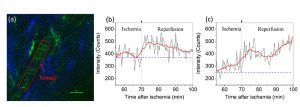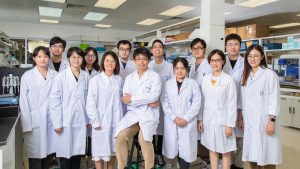A research team led by Liu Tzu-Ming, associate professor in the Faculty of Health Sciences (FHS) at the University of Macau (UM), has made a breakthrough in the diagnosis of acute mesenteric ischemia (AMI). The study found that the level of riboflavin (vitamin B2) in the blood correlates with the duration of intestinal ischemia and the degree of damage to the small intestine, making it a new diagnostic biomarker that can contribute to efficient early screening and reduce the mortality of patients. The research results have been published in the international journal Thrombosis Research.
The clinical symptoms of AMI are easily confused with those of other intestinal inflammatory diseases. Clinical data shows that failure to accurately predict the onset of AMI early and delayed diagnosis and treatment can lead to systemic response syndrome and multi-organ failure, resulting in a high mortality rate of 60 to 80 per cent. Therefore, accurate diagnosis of AMI remains a critical scientific problem in critical care medicine for patients with acute abdominal pain, as it can help avoid delayed diagnosis and treatment.
Currently, the clinical diagnosis of AMI relies on biomarker assays and CT imaging. However, biomarker assays are not only time-consuming but also unreliable due to significant individual variations in baseline levels, while CT imaging can only confirm the diagnosis of AMI at advanced stages of the disease. In view of this, the research team proposed a reagent-free fluorescence diagnosis method to reduce the time needed for early diagnosis.
The research team excited blood fluorescence at different wavelengths and used the fluorescent intensity to determine the pathology of AMI. The data showed that the intestine of AMI rats released a significant amount of riboflavin into the bloodstream, and the disease development can then be assessed by monitoring the fluorescence intensity of riboflavin in plasma. The intensity of riboflavin fluorescence is proportional to the duration of ischemia, and the ratio of fluorescence intensity of two different fluorescent molecules (flavin/NADH) can reflect the onset of shock. Furthermore, the plasma fluorescence assay takes less than two minutes to perform and does not need any additional reagents, providing a significant time advantage over traditional biomarker assays, which can take two to four hours.
Prof Liu is the corresponding author of the paper, his PhD student Wu Xueqin from UM is the first author, and PhD students Guo Lun-Zhang and Liu Yi-Hung from Taiwan University are the co-first authors. In addition, former research assistant Liu Yu-Cheng of UM FHS, Prof Tai Hwan-Ching from Xiamen University, professors Wang Tzung-Dau, Chou Pi-Tai and Lai I-Rue, and doctors Lai Chao-Lun and Chuang Yueh-Hsun from Taiwan University also made significant contributions to the study. The project was funded by the Science and Technology Development Fund of Macao SAR (File no: 122/2016/A3, 018/2017/A1, 0011/2019/AKP, 0120/2020/A3, 0026/2021/A), UM (File no: MYRG2018-00070-FHS). To view the full version of the paper, please visit: https://www.sciencedirect.com/science/article/pii/S0049384823000397?via%3Dihub.
| Source: Faculty of Health Sciences | |
| Media Contact Information: | |
| Communications Office, University of Macau | |
| Albee Lei | Tel: (853) 8822 8004 |
| Bell Leong | Tel: (853) 8822 8009 |
| Email: | prs.media@um.edu.mo |


